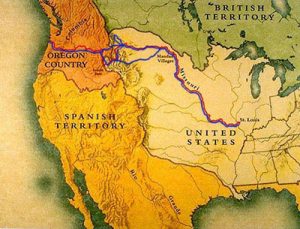
Map of Lewis and Clark Expedition (Source: Wikimedia Commons)
The Lewis and Clark Expedition from May 1804 to September 1806, also known as the Corps of Discovery Expedition, was the first American expedition to cross what is now the western portion of the United States. It began near St. Louis, made its way westward, and passed through the continental divide to reach the Pacific coast. The Corps of Discovery comprised a selected group of U.S. Army volunteers under the command of Captain Meriwether Lewis and his close friend, Second Lieutenant William Clark.
President Thomas Jefferson commissioned the expedition shortly after the Louisiana Purchase in 1803 to explore and to map the newly acquired territory, to find a practical route across the western half of the continent, and to establish an American presence in this territory before Britain and other European powers tried to claim it.
The campaign’s secondary objectives were scientific and economic: to study the area’s plants, animal life, and geography, and to establish trade with local Native American tribes. With maps, sketches, and journals in hand, the expedition returned to St. Louis to report its findings to Jefferson. Wikipedia
Learn more about the Lewis and Clark Expedition through historical newspapers from our archives. Explore newspaper articles, headlines, images, and other primary sources below.
Articles and Clippings about the Lewis and Clark Expedition
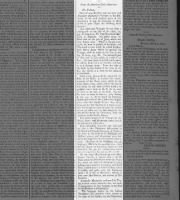 Article about Alexander Mackenzie, who completed the first crossing of North America in 1793 26 Jun 1804, Tue Lancaster Intelligencer (Lancaster, Pennsylvania) Newspapers.com
Article about Alexander Mackenzie, who completed the first crossing of North America in 1793 26 Jun 1804, Tue Lancaster Intelligencer (Lancaster, Pennsylvania) Newspapers.com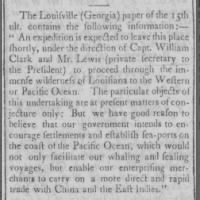 Newspaper announcement that the Lewis and Clark Expedition is "expected to leave [...] shortly" 04 Oct 1803, Tue Vermont Gazette (Bennington, Vermont) Newspapers.com
Newspaper announcement that the Lewis and Clark Expedition is "expected to leave [...] shortly" 04 Oct 1803, Tue Vermont Gazette (Bennington, Vermont) Newspapers.com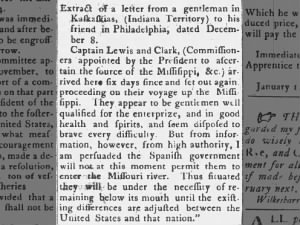 Letter from a man in Indiana Territory to a friend in Philadelphia regarding Lewis and Clark Sat, Jan 14, 1804 – 3 · The Gleaner (Wilkes-Barre, Pennsylvania) · Newspapers.com
Letter from a man in Indiana Territory to a friend in Philadelphia regarding Lewis and Clark Sat, Jan 14, 1804 – 3 · The Gleaner (Wilkes-Barre, Pennsylvania) · Newspapers.com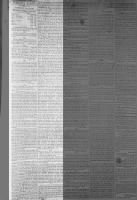 A letter written in April 1805 from Meriwether Lewis to Pres. Thomas Jefferson about the expedition 24 Jul 1805, Wed Virginia Argus (Richmond, Virginia) Newspapers.com
A letter written in April 1805 from Meriwether Lewis to Pres. Thomas Jefferson about the expedition 24 Jul 1805, Wed Virginia Argus (Richmond, Virginia) Newspapers.com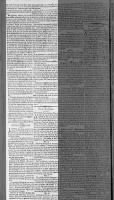 Newspaper reports letters were received from Lewis & Clark and gives highlights of their journey 29 Jul 1805, Mon Weekly Wanderer (Randolph, Vermont) Newspapers.com
Newspaper reports letters were received from Lewis & Clark and gives highlights of their journey 29 Jul 1805, Mon Weekly Wanderer (Randolph, Vermont) Newspapers.com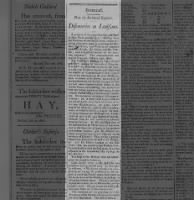 Article describes 123-page pamphlet with message from Pres. Jefferson about Lewis & Clark Expedition 02 Aug 1806, Sat Rutland Weekly Herald (Rutland, Vermont) Newspapers.com
Article describes 123-page pamphlet with message from Pres. Jefferson about Lewis & Clark Expedition 02 Aug 1806, Sat Rutland Weekly Herald (Rutland, Vermont) Newspapers.com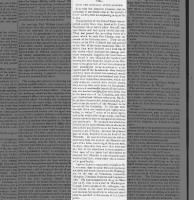 Letter to Thomas Jefferson about Lewis and Clark's expedition and return to St. Louis in 1806 30 Oct 1806, Thu Aurora General Advertiser (Philadelphia, Pennsylvania) Newspapers.com
Letter to Thomas Jefferson about Lewis and Clark's expedition and return to St. Louis in 1806 30 Oct 1806, Thu Aurora General Advertiser (Philadelphia, Pennsylvania) Newspapers.com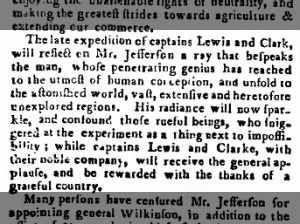 Lewis and Clark and company are given thanks for their efforts Fri, Nov 28, 1806 – Page 2 · The Sprig Of Liberty (Gettysburg, Pennsylvania) · Newspapers.com
Lewis and Clark and company are given thanks for their efforts Fri, Nov 28, 1806 – Page 2 · The Sprig Of Liberty (Gettysburg, Pennsylvania) · Newspapers.com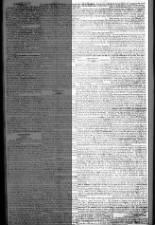 Copy of a letter written by Captain William Clark to his brother, General Clark, in 1806 Tue, Dec 30, 1806 – Page 3 · The Times (London, Greater London, England) · Newspapers.com
Copy of a letter written by Captain William Clark to his brother, General Clark, in 1806 Tue, Dec 30, 1806 – Page 3 · The Times (London, Greater London, England) · Newspapers.com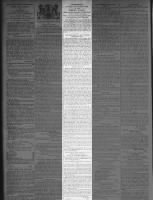 Newspaper publishes prospectus outlining Lewis and Clark’s book about their expedition 01 Jul 1807, Wed Aurora General Advertiser (Philadelphia, Pennsylvania) Newspapers.com
Newspaper publishes prospectus outlining Lewis and Clark’s book about their expedition 01 Jul 1807, Wed Aurora General Advertiser (Philadelphia, Pennsylvania) Newspapers.com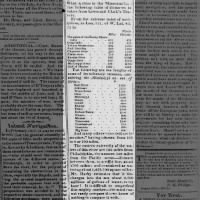 A "table of distances" for the Missouri River "taken from Lewis and Clark's Travels" 01 Sep 1819, Wed Missouri Gazette and Public Advertiser (St. Louis, Missouri) Newspapers.com
A "table of distances" for the Missouri River "taken from Lewis and Clark's Travels" 01 Sep 1819, Wed Missouri Gazette and Public Advertiser (St. Louis, Missouri) Newspapers.com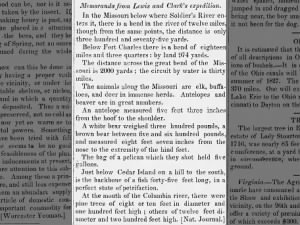 Record from Lewis and Clark’s expedition Fri, Jul 7, 1826 – 3 · New England Farmer (Boston, Massachusetts) · Newspapers.com
Record from Lewis and Clark’s expedition Fri, Jul 7, 1826 – 3 · New England Farmer (Boston, Massachusetts) · Newspapers.com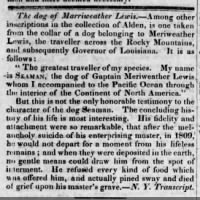 Article about Seaman, Meriwether Lewis's dog who went on the Lewis and Clark Expedition 29 Apr 1835, Wed The Rhode-Island Republican (Newport, Rhode Island) Newspapers.com
Article about Seaman, Meriwether Lewis's dog who went on the Lewis and Clark Expedition 29 Apr 1835, Wed The Rhode-Island Republican (Newport, Rhode Island) Newspapers.com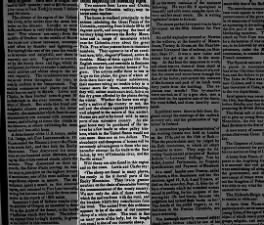 Two extracts from Lewis and Clark about the Columbia valley Fri, Nov 9, 1838 – Page 1 · Democrat and Herald (Wilmington, Ohio) · Newspapers.com
Two extracts from Lewis and Clark about the Columbia valley Fri, Nov 9, 1838 – Page 1 · Democrat and Herald (Wilmington, Ohio) · Newspapers.com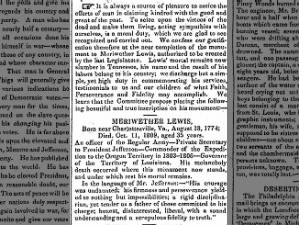 Captain Meriwether Lewis’ death recognition and monument Wed, Oct 25, 1848 – Page 2 · The Tennessean (Nashville, Tennessee) · Newspapers.com
Captain Meriwether Lewis’ death recognition and monument Wed, Oct 25, 1848 – Page 2 · The Tennessean (Nashville, Tennessee) · Newspapers.com Town named after man who was a member of Lewis and Clark’s exploring expedition Thu, Feb 17, 1853 – Page 1 · Glasgow Weekly Times (Glasgow, Missouri) · Newspapers.com
Town named after man who was a member of Lewis and Clark’s exploring expedition Thu, Feb 17, 1853 – Page 1 · Glasgow Weekly Times (Glasgow, Missouri) · Newspapers.com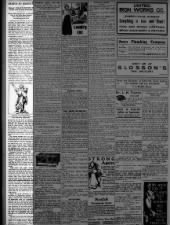 Statue honoring Sacagawea, Lewis and Clark's guide during their expedition Wed, Jul 26, 1905 – Page 2 · The Coffeyville Daily Journal (Coffeyville, Kansas) · Newspapers.com
Statue honoring Sacagawea, Lewis and Clark's guide during their expedition Wed, Jul 26, 1905 – Page 2 · The Coffeyville Daily Journal (Coffeyville, Kansas) · Newspapers.com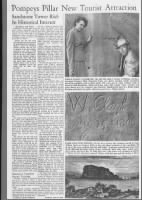 "Pompeys Pillar New Tourist Attraction" (including photo of William Clark's carved signature) 27 May 1956, Sun Great Falls Tribune (Great Falls, Montana) Newspapers.com
"Pompeys Pillar New Tourist Attraction" (including photo of William Clark's carved signature) 27 May 1956, Sun Great Falls Tribune (Great Falls, Montana) Newspapers.com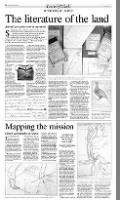 Articles discussing journals and maps from the Lewis and Clark Expedition 12 Jan 2003, Sun Richmond Times-Dispatch (Richmond, Virginia) Newspapers.com
Articles discussing journals and maps from the Lewis and Clark Expedition 12 Jan 2003, Sun Richmond Times-Dispatch (Richmond, Virginia) Newspapers.com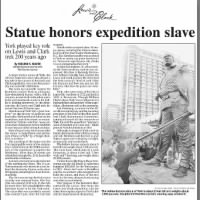 "York played key role on Lewis & Clark trek" - Statue honoring York unveiled in Louisville, Kentucky 15 Oct 2003, Wed The Courier-Journal (Louisville, Kentucky) Newspapers.com
"York played key role on Lewis & Clark trek" - Statue honoring York unveiled in Louisville, Kentucky 15 Oct 2003, Wed The Courier-Journal (Louisville, Kentucky) Newspapers.com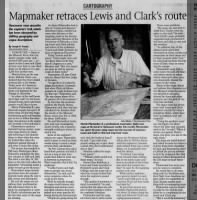 "Mapmaker retraces Lewis and Clark's route" "Vancouver man unearths the explorers' trail" 21 Nov 2003, Fri Longview Daily News (Longview, Washington) Newspapers.com
"Mapmaker retraces Lewis and Clark's route" "Vancouver man unearths the explorers' trail" 21 Nov 2003, Fri Longview Daily News (Longview, Washington) Newspapers.com